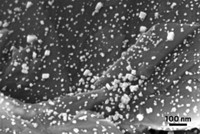Advertisement
Grab your lab coat. Let's get started
Welcome!
Welcome!
Create an account below to get 6 C&EN articles per month, receive newsletters and more - all free.
It seems this is your first time logging in online. Please enter the following information to continue.
As an ACS member you automatically get access to this site. All we need is few more details to create your reading experience.
Not you? Sign in with a different account.
Not you? Sign in with a different account.
ERROR 1
ERROR 1
ERROR 2
ERROR 2
ERROR 2
ERROR 2
ERROR 2
Password and Confirm password must match.
If you have an ACS member number, please enter it here so we can link this account to your membership. (optional)
ERROR 2
ACS values your privacy. By submitting your information, you are gaining access to C&EN and subscribing to our weekly newsletter. We use the information you provide to make your reading experience better, and we will never sell your data to third party members.
Synthesis
Artificial Photosynthesis Device Paves Way Toward Sustainable Liquid Fuel
Clean Energy: Solar-powered prototype transforms carbon dioxide to acetate, a feedstock for making high-value chemicals
by Deirdre Lockwood
April 23, 2015

Imagine a device that could take the exhaust from a power plant and turn it into liquid fuel using solar energy. Now, by integrating nanowire arrays with carbon dioxide-reducing bacteria, researchers have designed a prototype system that takes a first step toward that reality. The system mimics photosynthesis by using sunlight, water, and CO2 to create carbon-based compounds (Nano Lett. 2015, DOI: 10.1021/acs.nanolett.5b01254).
Current devices that imitate photosynthesis in plants focus on using sunlight and a photocatalyst to convert water into hydrogen gas, which can be used as fuel. But for today’s transportation engines, liquid, carbon-based fuels such as butanol are much more practical. To produce these with a photosynthetic device, researchers need to take another page out of the plants’ playbook: reducing CO2 to make molecules with carbon-carbon bonds.
So far, reducing CO2 with an artificial system has been more challenging than splitting water, says Peidong Yang of Lawrence Berkeley National Laboratory. For both processes, the first step is capturing sunlight with a semiconductor. Although researchers have successfully combined semiconductors with powerful synthetic catalysts to evolve H2 from water, they hadn’t synthesized molecules that efficiently reduce CO2.
“This led to our crazy idea,” says Yang. “If we don’t have suitable man-made catalysts, let’s look in nature.” Although CO2-reducing enzymes are made by both plants and microbes, the molecules tend to become unstable when removed from living cells. To find an organism that could do the job, Yang’s group teamed up with collaborators Christopher J. Chang and Michelle C. Y. Chang and chose Sporomusa ovata, an anaerobic bacterium that efficiently reduces CO2 to acetate, which can be used to make more complex and valuable carbon compounds.
To test the idea, the group built a small prototype that integrated S. ovata with a system that contains a pair of 2-cm2 nanowire arrays that serve as photoelectrodes. At the photoanode, titanium dioxide nanowires efficiently absorb light to generate an electric current and split water. The photocathode has silicon nanowires with a high surface area that is effectively colonized by the bacteria. When the array chamber is filled with an electrolyte solution containing CO2, the current prompts the bacteria to reduce CO2 to acetate.
The system produced up to 6 g/L of acetate over a period of five days. The researchers removed the acetate and used genetically engineered Escherichia coli strains to transform it into acetyl coenzyme A. Other strains then produced more valuable chemicals such as n-butanol, the plastic polyhydroxybutyrate, and three isoprenoid natural products, which are pharmaceutical precursors.
The team’s prototype converts solar energy to acetate with an efficiency of 0.4%, which is comparable to that of natural photosynthesis. But to move toward a commercial device, Yang’s team will need to boost the efficiency to at least 2%. The team is now working on a new system to meet this goal, Yang says, as well as synthetic catalysts that could replace the bacteria.
“This is a very nice piece of work,” says John H. Golbeck of Pennsylvania State University. A key advance in this device, he says, is that it integrates bacteria directly with a semiconductor, rather than connecting them indirectly, as in microbial fuel cells. Although the system’s solar energy conversion efficiency is currently low, he says, “this is a proof-of-concept device, and good engineering will undoubtedly improve on that number.”




Join the conversation
Contact the reporter
Submit a Letter to the Editor for publication
Engage with us on Twitter